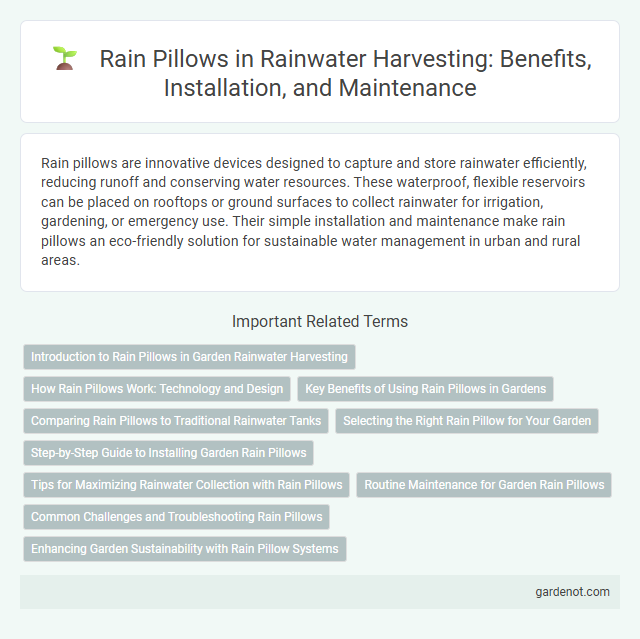Rain pillows are innovative devices designed to capture and store rainwater efficiently, reducing runoff and conserving water resources. These waterproof, flexible reservoirs can be placed on rooftops or ground surfaces to collect rainwater for irrigation, gardening, or emergency use. Their simple installation and maintenance make rain pillows an eco-friendly solution for sustainable water management in urban and rural areas.
Introduction to Rain Pillows in Garden Rainwater Harvesting
Rain pillows are innovative water storage devices designed to collect and store rainwater in garden settings, promoting sustainable water management. These flexible, durable bladders can be installed underground or above ground, capturing runoff from rooftops or rain gardens to supply irrigation needs. Their efficient design reduces water waste, mitigates soil erosion, and supports drought resilience in residential landscapes.
How Rain Pillows Work: Technology and Design
Rain pillows utilize advanced impermeable bladders filled with water that expand to capture and store rainwater effectively while preventing contamination and evaporation. Their design includes durable, UV-resistant materials and vent systems that equalize pressure, allowing seamless overflow management and integration with drainage infrastructure. This innovative technology supports rainwater harvesting by enhancing storage efficiency and durability for green roofs and urban stormwater management systems.
Key Benefits of Using Rain Pillows in Gardens
Rain pillows enhance garden irrigation by efficiently capturing and distributing rainwater to plant roots, reducing water runoff and soil erosion. They promote water conservation by storing rainwater for extended periods, ensuring plants receive consistent hydration during dry spells. Incorporating rain pillows helps maintain soil moisture levels, leading to healthier plant growth and improved garden sustainability.
Comparing Rain Pillows to Traditional Rainwater Tanks
Rain pillows offer a flexible and space-saving alternative to traditional rainwater tanks, designed with durable, lightweight materials that can be easily installed on rooftops or balconies. Unlike rigid tanks, rain pillows adapt to available spaces and reduce installation costs while maintaining efficient water storage capacity. These innovative systems minimize water stagnation and contamination risks commonly associated with conventional tanks, enhancing rainwater quality for residential use.
Selecting the Right Rain Pillow for Your Garden
Choosing the right rain pillow for your garden involves considering the pillow's size, material, and water retention capacity to effectively capture and store rainwater. Opt for rain pillows made of durable, UV-resistant fabric with a high absorption rate to ensure longevity and maximum efficiency. Matching the rain pillow's size to your garden's water needs can optimize irrigation while minimizing water waste.
Step-by-Step Guide to Installing Garden Rain Pillows
Installing garden rain pillows begins with selecting a suitable downspout or drainage area where water accumulation is desired. Place the rain pillow flat against the soil or landscaping fabric, ensuring it is positioned to capture runoff effectively and stabilize irrigation. Secure the pillow with stakes or anchor systems to prevent displacement, then regularly monitor water absorption and adjust placement for optimal rainwater harvesting performance.
Tips for Maximizing Rainwater Collection with Rain Pillows
Place rain pillows on flat or slightly sloped surfaces to maximize water retention and reduce runoff. Regularly clean and check for clogs or debris to maintain optimal water absorption and storage efficiency. Use multiple rain pillows interconnected to increase capacity and enhance rainwater harvesting during heavy rainfall.
Routine Maintenance for Garden Rain Pillows
Routine maintenance for garden rain pillows involves regularly inspecting the fabric for punctures or wear to ensure optimal water absorption and storage. Clearing debris, such as leaves and dirt, from the surface prevents clogging and promotes efficient drainage. Seasonal cleaning with mild detergent helps maintain the pillow's durability and extends its functional lifespan in rainwater harvesting systems.
Common Challenges and Troubleshooting Rain Pillows
Rain pillows often face challenges such as clogging from debris, punctures, and material degradation due to prolonged UV exposure. Regular inspection and cleaning can prevent blockages, while punctures require patched repairs with compatible waterproof materials to maintain efficiency. Using UV-resistant covers and positioning the rain pillow in shaded areas helps extend its lifespan and ensures optimal rainwater collection.
Enhancing Garden Sustainability with Rain Pillow Systems
Rain pillow systems enhance garden sustainability by efficiently capturing and storing rainwater, reducing reliance on groundwater and municipal water supplies. These systems use durable, flexible pillows that collect runoff from rooftops, providing a steady water source for irrigation during dry periods. By minimizing water waste and promoting natural water retention, rain pillows support healthier plant growth and lower environmental impact.
Rain pillow Infographic

 gardenot.com
gardenot.com